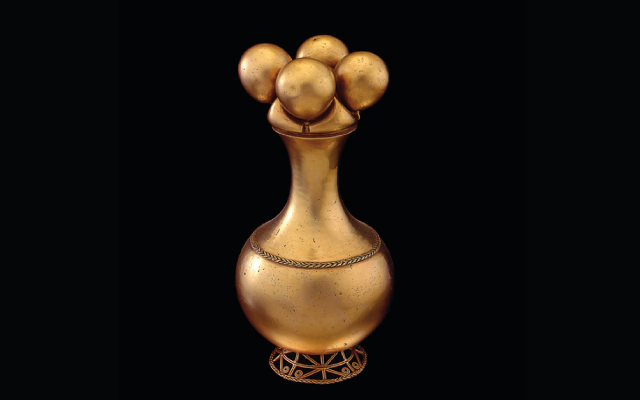The Poporo Quimbaya
Gold, Memory, and the Ancient Americas
Long before gold was worked in Egypt or Europe, it was being cast in the highlands of Colombia. More than two thousand years ago, artisans of the Quimbaya culture shaped it into vessels used for ritual and daily life. The Poporo Quimbaya connects not only to Colombia’s past, but to a broader metallurgical tradition that stretched across the ancient Americas, following the course of rivers long before colonial contact.

Poporos held powdered lime used in the preparation of coca leaves, a substance central to Andean societies for its social, medicinal, and spiritual roles. The vessel turned an everyday act into ceremony. Its form echoed the shape of a gourd—an object associated with nourishment and fertility—and translated that association into metal. The Quimbaya version, rendered in gold, transforms a living plant form into a lasting container.
The poporo was made of tumbaga, an alloy of gold and copper that sometimes included traces of silver. Easier to cast than pure gold, it offered a warm tone and resilience suited to complex forms. After casting, the surface was refined through depletion gilding, a technique that drew copper from the outer layer by applying acidic plant extracts and heat. What remained was a skin rich in gold, polished to reflect light. The process required patience and deep familiarity with materials. Artisans are thought to have used fine sand, fibers, and animal hide to burnish the surface—tools drawn directly from their surroundings.
Its making relied on lost-wax casting, a method that replaces wax with molten metal inside a clay mold. The result is hollow and seamless. This approach appeared independently in several parts of the world, but in the Andes it evolved through local innovation. Similar techniques appear in objects from Ecuador, Peru, and Bolivia, suggesting that metalworking knowledge traveled by river and trade, not by conquest. Waterways linked highlands and coasts, carrying tools and ideas alongside the people who shaped them.
That flow was later disrupted. Spanish colonization led to the mass melting of gold artifacts, their metal converted into bullion and shipped abroad. The loss was both artistic and cultural. What survived often left the continent, reappearing in European museums as trophies of empire. The Poporo Quimbaya is one of the few that remained in Colombia. Acquired in 1939 by the Bank of the Republic, it became the first object in the national gold collection and the centerpiece of Bogotá’s Museo del Oro. It appears on banknotes and state emblems as a symbol of endurance.
For Iaia Caravan, the poporo stands as a record of technique and transmission—of knowledge passed through generations of goldsmiths. Lost-wax casting, alloy making, and depletion gilding continue to be practiced today in workshops across the Global South. These are living languages of metal, not relics of the past.
Working in 22-karat gold places us within that same continuum. In ancient America, gold was not locked away; it was used, exchanged, worn against the skin. Meaning came from its making and its movement. The Poporo Quimbaya reminds us that a vessel can hold more than substance—it can hold memory itself.